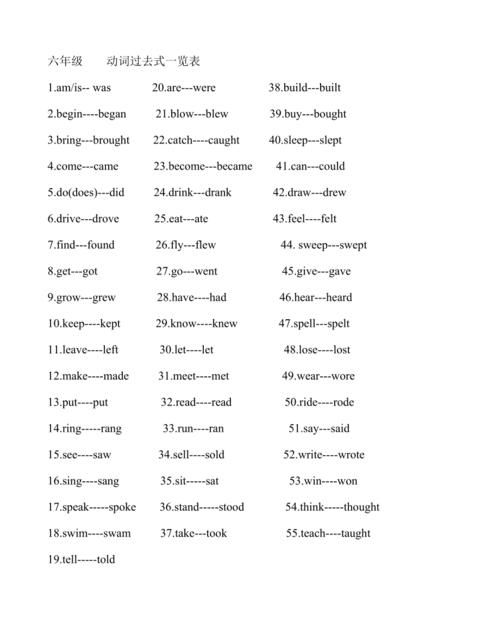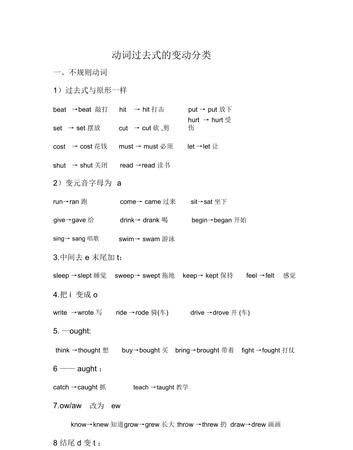本文目录
六年级上册英语动词有哪些
一至六年级的英语动词有be动词、情态动词、助动词、行为动词。
一、be动词(am,is,are,was,were )
1、amwas,is was,are--were口诀:我用am,你用are,is用在他她它,所有复数全用are。
2、肯定和否定句I am (not) from London. He is(not) a teacher. She is(not) in the dining room. My hair is(not) long. Her eyes are(not) small.
3、一般疑问句Am I a Chinese? Yes,you are. No,you arent. Are they American? Yes,they are. No,they arent. Is the cat fat? Yes,it is. No,it isnt.
4、be动词的否定形式:am not(没有缩写形式),are not = arent,is not = isnt.

二、助动词(do,does,did )
do,does用于一般现在时,其过去式did用于一般过去时。它们通常用在疑问句和否定句中。它们的否定形式:do not = dont,does not = doesnt,did not = didnt.
注意:在一般现在时中,does用于第三人称单数,其余一律用助动词do;助动词do,does,did后面一定要用动词原形。
三、情态动词
情态动词也是一类特殊的动词,平时我们不把它说成是动词。情态动词可以和行为动词同时出现在同一个句子中。我们现在学过的情态动词有:can、could、shall、should、will、would、may、might、must.注意:情态动词后动词总是用原形。(不受其他任何条件影响)
四、行为动词
就是平时上课时说的动词,表示某一动作或行为。如:sweep、live等。行为动词我们已学过它们的四种形式:原形、第三人称单数+s/es、现在分词(也叫动名词)+ing、过去式+ed。
动词第三人称单数变化规则:
A、一般直接加s,如:play plays,visit visits,speak speaks.
B、以s,x,sh,ch结尾时,加es,如:catch catches,watch watches.
C、以辅音字母+y结尾时,变y为i再加es,如:carry carries,study studies.
一至六年级必学的英语单词
英语单词词性
n. 名词 v. 动词 pron. 代词
adj. 形容词 adv. 副词 num.数词
art. 冠词 prep. 介词 conj. 连词
interj. 感叹词
英语词性缩写
prep = 介系词;前置词,preposition的缩写
pron = 代名词,pronoun的缩写
n = 名词,noun的缩写
v = 动词,兼指及物动词和不及物动词,verb的缩写
cOnj= 连接词 ,conjunction的缩写
s = 主词
sc = 主词补语
o = 受词
oc = 受词补语
vi = 不及物动词,intransitive verb的缩写
vt = 及物动词,transitive verb的缩写
aux.v = 助动词 ,auxiliary的缩写
a = 形容词,adjective的缩写
ad = 副词,adverb的缩写
art = 冠词,article的缩写
num = 数词,numeral的缩写
int = 感叹词,interjection的缩写
u = 不可数名词,uncountable noun的缩写
c = 可数名词,countable noun的缩写
pl = 复数,plural的缩写
语气词 int.
缩写词 abbr.
abbr abbreviation(略)略语
adj, adjjadjective(s)(形)形容词
adv, advvadverb(s)(副)副词
adv partadverbial particle(副接)副词接语
aux auxiliary(助)助动词
cn countable noun(可数)可数名词
conj conjunction(连)连接
def art definite article(定冠)定冠词
egfor example(例如)例如
esp especially(尤指)尤指
etc and the others(等)等等
ie which is to say(意即)意即
indef art indefinite article(不定冠词)不定冠词
inf infinitive(不定词)不定词
int interjection(感)感叹词
n noun(s) (名)名词
neg negative(ly)(否定)否定的(地)
part adj participial adjective(分形)分词形容词
pers person(人称)人称
pers pron personal pronoun(人称代)人称代名词
pl plural(复)复数(的)
pp past participle (过去分词)过去分词
pref prefix(字首)字首
prep preposition(al) (介词)介词,介系词,介词的
pron pronoun (代)代名词
pt past tense(过去)过去式
sb somebody(某人)某人
sing singular(单)单数(的)
sth something(某事物)某物或某事
suff suffix(字尾)字尾

发音英语动词和名词
PEP六年级下册四会单词词汇表
Unit 1
tall—taller更高的 short—shorter 更矮的 strong—stronger 更强壮的 old—older 年龄更大的 young—younger 更年轻的 big—bigger 更大的heavy—heavier 更重的 long—longer 更长的 thin—thinner 更瘦的 small—smaller (体型)更小的
答案补充 太多了,打不完

三到六年级英语所有动词名词
第一方面:按词义和句中的作用,动词可以分为四类。见下表。
类别
特点
意义
举例
实义动词 (vt. vi.)
及物动词跟宾语
须跟宾语一起才能表达完整的意思
I have a book..
不及物动词不能直接接宾语
能独立作谓语
She always comes late.
系动词(link-v)
跟表语
不能独立做谓语,跟表语构成完整意思
I am a student.
助动词(aux. v.)
跟动词原形或分词(无词汇意义)
不能独立做谓语,跟主要动词构成谓语,表示疑问,否定及各种时态
He doesn’t speak Chinese.
I am watching TV.
情态动词 (mod. v.)
跟动词原形(有自己的词汇意思)
不能独立做谓语。表示说话人语气、情态,无人称和数的变化
We can do it by ourselves.
That would be better.
第二方面:短语动词,短语动词是由一些动词和其它词构成短语,表达一个完整的意思。其构成方式如下。
构成方式
举例
动词+介词
Look at, look after
动词+副词
Give up, put into
动词+副词+介词
Catch up with, look down upon
动词+名词+介词
Take care of, pay attention to
Be+形容词+介词
Be proud of, be afraid of
复杂结构
Make up one’s mind, wind one’s way
第三方面:按动词的形式可以分为谓语动词和非谓语动词。
1、谓语动词
形式
意义
举例
人称
与主语在人称一致
I am reading now. 第一人称
数
与主语在数上一致
He writes well. 第三人称单数
时态
表示动作发生的时间
He wrote a letter to me last month. 过去时态
语态
主语是动作的发生者或者承受者
We study English.主动
The road was filled with rubbish. 被动
语气
说话人表达事实、要求、愿望等
He has flown to America. 事实
I wish I could fly to the moon some day. 愿望
2、非谓语动词
形式
意义
用途
举例
不定式
起形容词和名词作用
可作主语、表语、宾语、定语、状语
It takes me 20 minutes to go to school.
动名词
起名词作用
作主语和宾语
She likes reading.
分词
现在分词
起形容词、副词作用,表主动
作表语、定语、状语、宾语补足语
The cup is broken
过去分词
起形容词、副词作用,表被动
The steam is seen rising from the wet clothes.

以上就是关于至6年级英语00个动词 ,六年级上册英语动词有哪些的全部内容,以及1至6年级英语100个动词 的相关内容,希望能够帮到您。
